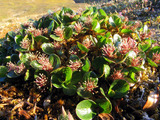580210 Salix polaris Wahlenb.
Distribution
Northern Fennoscandia: Rare
Kanin - Pechora: Scattered
Svalbard - Franz Joseph Land: Frequent
Polar Ural - Novaya Zemlya: Frequent
Yamal - Gydan: Frequent
Taimyr - Severnaya Zemlya: Frequent
Anabar - Onenyo: Frequent
Kharaulakh: Frequent
Yana - Kolyma: Scattered
West Chukotka: Frequent
Wrangel Island: Frequent
South Chukotka: Frequent
East Chukotka: Frequent
Western Alaska: Scattered
Northern Alaska - Yukon: Frequent
Central Canada: Scattered
Polar desert: Rare
Northern arctic Tundra: Frequent
Mid Arctic Tundra: Frequent
Southern Arcti Tundra: Frequent
Shrub Tundra: Scattered
Bordering boreal or alpine areas: Rare
- Wahlenb., Fl. Lapp.: 261 (1812). Lectotype (UPS THUNB-23096): Sweden: "Lapland" (Moberg and Nilsson 1991: 296).
- Salix pseudopolaris Flod., Ark. Bot. 20A, 6: 8 (1926). Described from Kamtchatka (the Russian Far East). Several syntypes cited. - Salix polaris subsp. pseudopolaris (Flod.) Hultén, Acta Univ. Lund., n. s., sect. 2, 39, 1: 510 (1944).
2n=
114 (6x). - Europe (N), Siberia (N), Far East (N). - Numerous reports.
Not included (Elven and Yurtsev): A report of 2n = 76 (4x) from Scandinavia (Marklund in Holmberg 1931) is unvouchered. Tetraploids are known from S. x nothula (S. herbacea x polaris) which is common in the Scandinavian mountains from where Marklund's count came. There is a report of a tetraploid also from the Putorana Plateau in northern Siberia (Krogulevich 1976a) where S. herbacea does not occur. However, the assumedly diploid and related S. nummularia occurs there and may hybridize. Petrovsky and Zhukova (1983a) reported 2n = 90 from northeastern Asia, probably from a hybrid, and Zhukova et al. (1977) 2n = >200 from northern Yakutia.
Geography: European (N) - Asian (N) - amphi-Beringian - North American (NW) & Asian (C): NOR RUS SIB RFE ALA CAN.
Notes: Argus: The characters used to separate Salix pseudopolaris from S. polaris, namely its light-colored floral bracts with wavy hairs and catkins with more flowers (Skvortsov 1966), are well within the range of variation of S. polaris.
Yurtsev: Variety calva Jurtz. & V.V. Petrovsky with brightly red glabrescent capsules is not rare in the amphi-Beringian regions.
Elven: Argus (2010) suggested that S. polaris may be an intersectional hybrid between sect. Myrtosalix and sect. Herbella.
Higher Taxa
- Salix [5802,genus]
